ASUS P9X79-E WS Review: Xeon meets PLX for 7x
by Ian Cutress on January 10, 2014 10:00 AM EST- Posted in
- Motherboards
- Asus
- Workstation
- X79
- Prosumer
Readers of our motherboard review section will have noted the trend in modern motherboards to implement a form of MultiCore Enhancement / Acceleration / Turbo (read our report here) on their motherboards. This does several things – better benchmark results at stock settings (not entirely needed if overclocking is an end-user goal), at the expense of heat and temperature, but also gives in essence an automatic overclock which may be against what the user wants. Our testing methodology is ‘out-of-the-box’, with the latest public BIOS installed and XMP enabled, and thus subject to the whims of this feature. It is ultimately up to the motherboard manufacturer to take this risk – and manufacturers taking risks in the setup is something they do on every product (think C-state settings, USB priority, DPC Latency / monitoring priority, memory subtimings at JEDEC). Processor speed change is part of that risk which is clearly visible, and ultimately if no overclocking is planned, some motherboards will affect how fast that shiny new processor goes and can be an important factor in the purchase.
Using our consumer level i7-4960X CPU, the P9X79-E WS does implement MultiCore Turbo when XMP is enabled. This gives a full 4.0 GHz CPU power under any loading.
Point Calculations - 3D Movement Algorithm Test
The algorithms in 3DPM employ both uniform random number generation or normal distribution random number generation, and vary in various amounts of trigonometric operations, conditional statements, generation and rejection, fused operations, etc. The benchmark runs through six algorithms for a specified number of particles and steps, and calculates the speed of each algorithm, then sums them all for a final score. This is an example of a real world situation that a computational scientist may find themselves in, rather than a pure synthetic benchmark. The benchmark is also parallel between particles simulated, and we test the single thread performance as well as the multi-threaded performance.
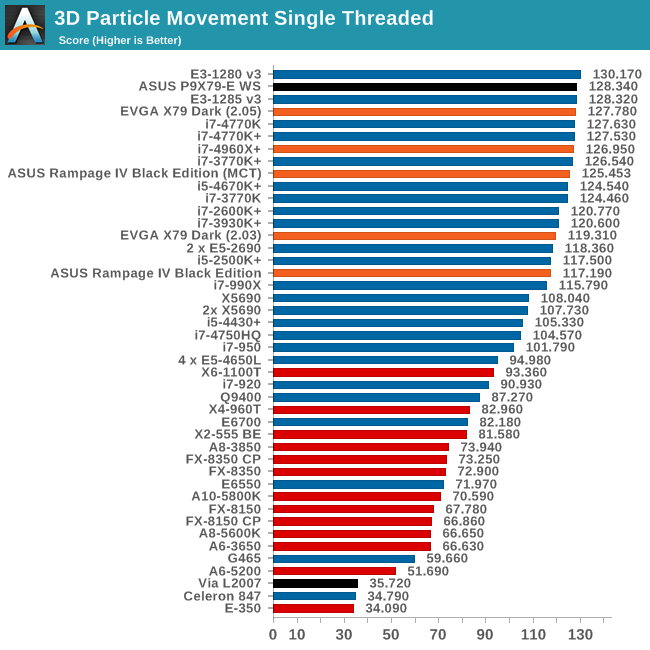
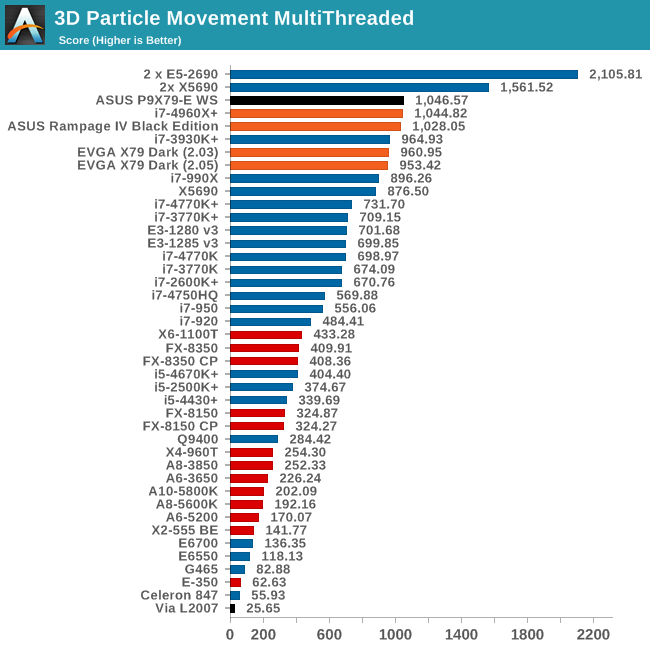
The P9X79-E WS results come across as very efficient in our 3DPM ST test, with none of the issues we found with the RIVBE coming through.
Compression - WinRAR 4.2
With 64-bit WinRAR, we compress the set of files used in the USB speed tests. WinRAR x64 3.93 attempts to use multithreading when possible, and provides as a good test for when a system has variable threaded load. WinRAR 4.2 does this a lot better! If a system has multiple speeds to invoke at different loading, the switching between those speeds will determine how well the system will do.

Image Manipulation - FastStone Image Viewer 4.2
FastStone Image Viewer is a free piece of software I have been using for quite a few years now. It allows quick viewing of flat images, as well as resizing, changing color depth, adding simple text or simple filters. It also has a bulk image conversion tool, which we use here. The software currently operates only in single-thread mode, which should change in later versions of the software. For this test, we convert a series of 170 files, of various resolutions, dimensions and types (of a total size of 163MB), all to the .gif format of 640x480 dimensions.
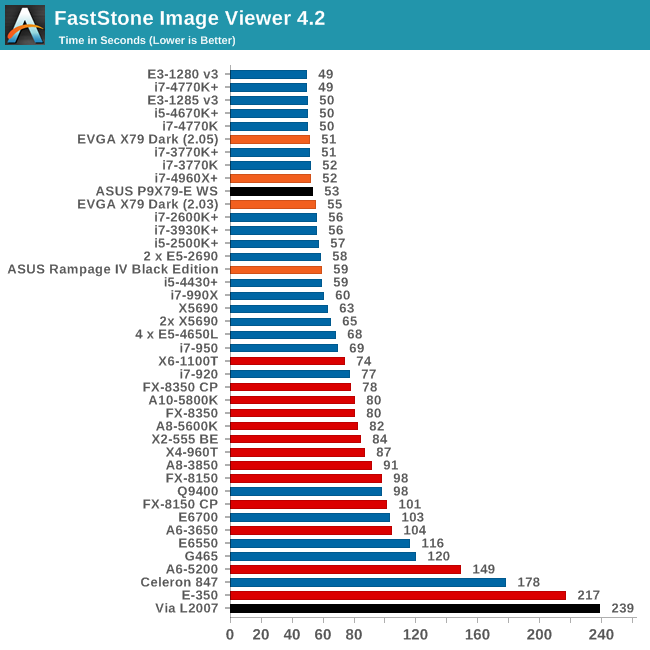
Again, the P9X79-E WS blasts past the RIVBE here due to the turbo issue.
Video Conversion - Xilisoft Video Converter 7
With XVC, users can convert any type of normal video to any compatible format for smartphones, tablets and other devices. By default, it uses all available threads on the system, and in the presence of appropriate graphics cards, can utilize CUDA for NVIDIA GPUs as well as AMD WinAPP for AMD GPUs. For this test, we use a set of 33 HD videos, each lasting 30 seconds, and convert them from 1080p to an iPod H.264 video format using just the CPU. The time taken to convert these videos gives us our result.

Rendering – PovRay 3.7
The Persistence of Vision RayTracer, or PovRay, is a freeware package for as the name suggests, ray tracing. It is a pure renderer, rather than modeling software, but the latest beta version contains a handy benchmark for stressing all processing threads on a platform. We have been using this test in motherboard reviews to test memory stability at various CPU speeds to good effect – if it passes the test, the IMC in the CPU is stable for a given CPU speed. As a CPU test, it runs for approximately 2-3 minutes on high end platforms.
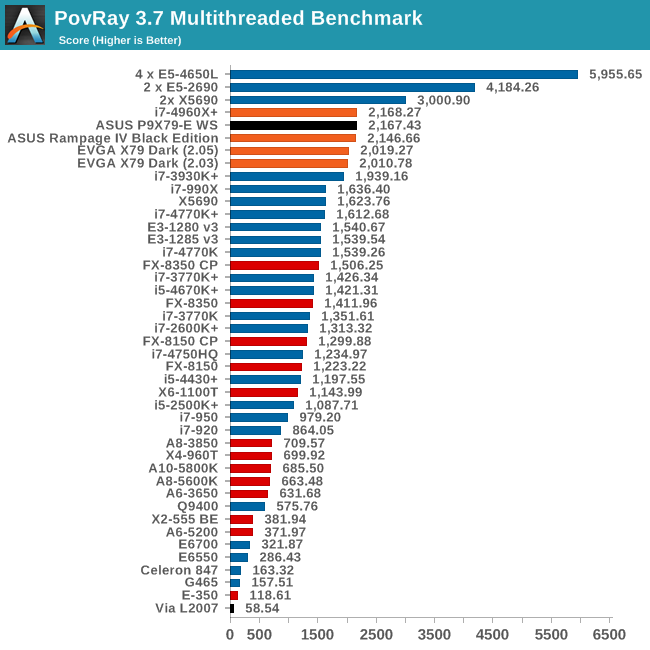
Video Conversion - x264 HD Benchmark
The x264 HD Benchmark uses a common HD encoding tool to process an HD MPEG2 source at 1280x720 at 3963 Kbps. This test represents a standardized result which can be compared across other reviews, and is dependent on both CPU power and memory speed. The benchmark performs a 2-pass encode, and the results shown are the average of each pass performed four times.

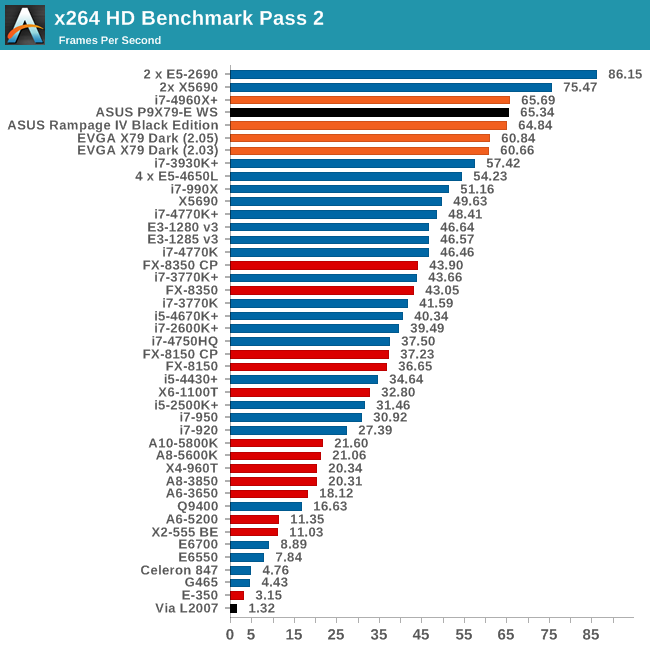
Grid Solvers - Explicit Finite Difference
For any grid of regular nodes, the simplest way to calculate the next time step is to use the values of those around it. This makes for easy mathematics and parallel simulation, as each node calculated is only dependent on the previous time step, not the nodes around it on the current calculated time step. By choosing a regular grid, we reduce the levels of memory access required for irregular grids. We test both 2D and 3D explicit finite difference simulations with 2n nodes in each dimension, using OpenMP as the threading operator in single precision. The grid is isotropic and the boundary conditions are sinks. Values are floating point, with memory cache sizes and speeds playing a part in the overall score.
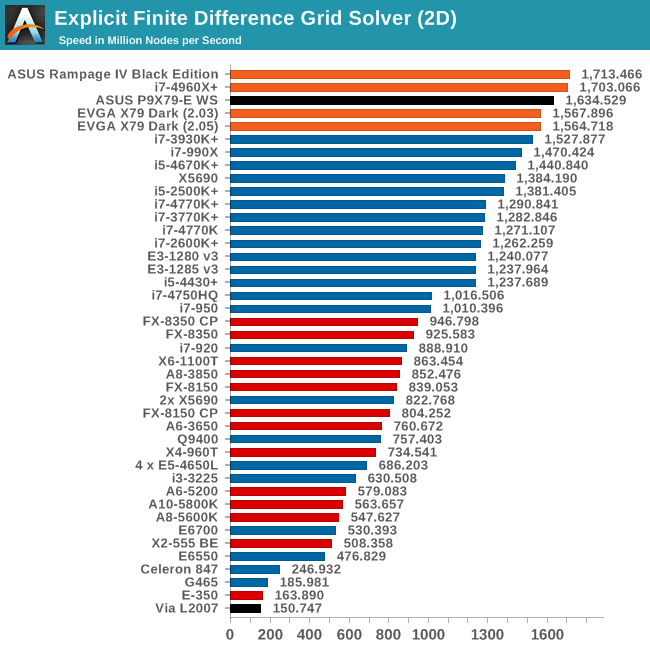

Interestingly something seems to be holding back the 2D Explicit numbers.
Grid Solvers - Implicit Finite Difference + Alternating Direction Implicit Method
The implicit method takes a different approach to the explicit method – instead of considering one unknown in the new time step to be calculated from known elements in the previous time step, we consider that an old point can influence several new points by way of simultaneous equations. This adds to the complexity of the simulation – the grid of nodes is solved as a series of rows and columns rather than points, reducing the parallel nature of the simulation by a dimension and drastically increasing the memory requirements of each thread. The upside, as noted above, is the less stringent stability rules related to time steps and grid spacing. For this we simulate a 2D grid of 2n nodes in each dimension, using OpenMP in single precision. Again our grid is isotropic with the boundaries acting as sinks. Values are floating point, with memory cache sizes and speeds playing a part in the overall score.
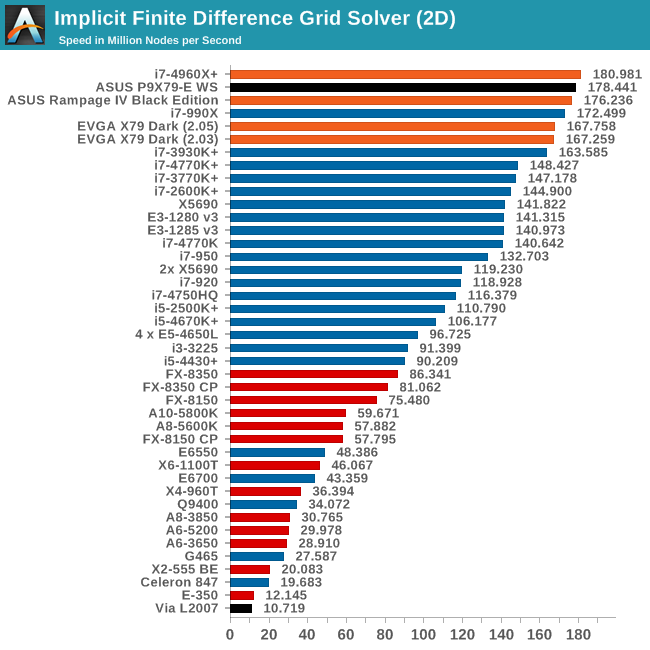
Point Calculations - n-Body Simulation
When a series of heavy mass elements are in space, they interact with each other through the force of gravity. Thus when a star cluster forms, the interaction of every large mass with every other large mass defines the speed at which these elements approach each other. When dealing with millions and billions of stars on such a large scale, the movement of each of these stars can be simulated through the physical theorems that describe the interactions. The benchmark detects whether the processor is SSE2 or SSE4 capable, and implements the relative code. We run a simulation of 10240 particles of equal mass - the output for this code is in terms of GFLOPs, and the result recorded was the peak GFLOPs value.











53 Comments
View All Comments
g00ey - Saturday, January 11, 2014 - link
When I looked at the user reviews on Newegg and forums, I saw that there are a lot of issues with this motherboard. So I went with the P9X79 WS motherboard instead that have less negative reviews.Perhaps there are a few issues with these PLX chips that needs to be addressed before it becomes stable...
Ian Cutress - Saturday, January 11, 2014 - link
I saw some of those reviews, mainly being linked to upgrading to Ivy-E, or buying one when they first come out and then upgrading to the CAP BIOS system. My review sample (as the ones on sale should be) was already in CAP, so I just put in the latest BIOS and it worked fine. The PLX chips are tried and tested in many other boards, so no issues there on the chip itself.g00ey - Saturday, January 11, 2014 - link
A motherboard that refuses to post because of a too modern CPU makes things very hard if you don't happen to have an "old" LGA2011 CPU lying around, and most people don't.But the PLX chips tend to give me the heebie jeebies when considering virtualized configurations that use PCI passthrough (IOMMU through Intel VT-d). It is a 'workstation grade' motherboard after all so such usage scenarios should be considered. It would be interesting to know how PLX switch chips affect the PCI passthrough capabilities.
Otherwise, a motherboard with 7 full-lane PCIe slots is really attractive but I guess a dual CPU motherboard is needed for that.
Ian Cutress - Saturday, January 11, 2014 - link
This is why these motherboards support USB BIOS Flashback: the ability to flash a BIOS onto the motherboard without a CPU, DRAM or a VGA installed. It requires renaming the BIOS file, putting it onto a suitable memory stick and following ASUS' instructions. I've used it a couple of times before, and as long as you follow the instructions it is ok: people get frustrated when it doesn't seem to work and there is no feedback (file misnamed, USB not suitable, BIOS not copied properly, BIOS still in old mode requires old BIOS not CAP BIOS).mazzy80 - Sunday, January 12, 2014 - link
Hi,I find the benches useless on Mobo review, all the Mobo perform the same of course +-1/2%, so nobody cares.
in this case the only useful Bench is to measure the impact of PLX of graphic performance in games. it's look like a minimal impact and this it' good, but you can see that x16@PCE3 Vs x8@PCIE3 is at moment of no use.
IMHO the Mobo review should be around stability, quirks, measuring features performance.
in this case :
performances of Marvel 930 and Asmedia SATA3 controllers Vs intel.
Performance of ASmedia USB3 Vs Intel z87.
Stability with 64GB RAM and 3-SLI.
I've this board for few days with E5-1650v2.
I don't like :
You can't run the cpu at Stock Intel Spec. If you enable the Turbo, you get all the core always at the turbo speed with Vcore ramp up. this is no good for a WS board. Why ? there's no option to disable Multicore option.
Fewer Sensor voltages to monitor that board at this price level.
The IB-E support isn't that great still. The default voltage are not correct for CPU PLL (1.8 instead 1.7) VTTIO (1.05 vs 1.00)
there's no way to respect Intel VID of the CPU, there're the manual fixed or the ASUS adaptive.
Like:
64GB rock solid at Intel Specs for VSSA (0.95V)
Stable so far.
mapesdhs - Sunday, January 12, 2014 - link
If you want to run everything at their baseline defaults, I don't see the relevance
of a board like this in the first place. The whole point of this WS board is that it
pairs the oc'ing features of the ROG series with the kind of workstation features
normally found on pro boards. It's an excellent middleground. You'd really want
to run 64GB at minimal speed, etc.? I have 64GB @ 2133 just fine. Plus, in
reality the various voltages you refer to vary from one chip to another wrt their
ideal baseline values; there are no absolutes.
If you want to run stuff at 'stock intel spec', then buy a boring ordinary XEON board,
not one like this which is intended to allow one to do sooo much more.
Ian.
mazzy80 - Monday, January 13, 2014 - link
well I dont' agree.I'd have prefer the options to run all at the specs and the options to 'switch' the gear with overclock. this is not a RIVE dressed in WS... and it'd not to be.
If you want to overclock to the hell the ROG extreme lines is for you.
If you want a stable classic workstation Mobo, with a Xeon, with the option to tweak it, if you wish, well this is what I think the WS lines should be, not a hybrid.
it lacks additional power for CPU for example... only one ordinary 8-pin and nothing else. I find it strange.
even Z87 boards have additional power input, and the Haswell top at 89W TDP from the start... E5-2687Wv2 is a 150W part at 3.4Ghz.... turbo @4GHz is over 200W..
If you buy a I7 why select this board ? there's the Deluxe for you, 2-3SLI to gamming ? RIVE/MF is for you.
This board is for Xeon, ECC memory first, so why force the cpu to run overclocked on stock settings?
mapesdhs - Wednesday, January 15, 2014 - link
The ROG boards are for gamers. I didn't buy one for gaming, so your logic is flawed
from the outset. I built a system for AE and wanted RAID card compatibility, among
other things. Plus, the only ROG board I felt was any good was a lot more expensive.
Whatever you might think the WS should be doesn't matter. It is what it is, a blend of
workstation and top-end gamer board features, the best of both IMO. I don't understand
your concerns; afterall, you don't *have* to oc on _any_ board. Leave everything at their
defaults and it'll be fine as-is. Me, I wanted 64GB RAM @ 2133 and a 6-core @ 4.7+,
with the ability to run four GPUs for CUDA, and RAID card support. The WS is perfect
for this. As for the CPU power issue, I don't see it as even being an issue. Where's your
evidence the WS in any way suffers from not having an extra power connector? The WS
will handle a 3930K @ 5.0 no problem.
Basically, your assumptions are wrong, and thus your conclusions are wrong. The Deluxe
was definitely not for me. The WS supports XEONs just as it supports i7s; saying it's "for"
one chip type or the other doesn't make sense.
For those who _are_ looking for a gaming board though then you do have a point, except
that the PCIe structure is better on the WS-E IMO.
Ian.
PS. And btw, how many CPU-Z submissions have you seen which have a ROG board
with a 3930K @ 4.7+ and max RAM at 2133+ with four GPUs? I've never seen one.
What I wanted to build is in a different league to gaming setups. Games tax just parts
of a system and often not much at that; AE hammers everything at times, gobbling 40GB
RAM no problem, hence the SSD for cache, etc.
viper131 - Sunday, January 12, 2014 - link
Question on the Dr. Power feature. Does this application show you the wattage usage on each separate PCI lane ? Also , did your GPU have a power feed direct from the PSU ?thanks,
luwalo - Tuesday, January 14, 2014 - link
Does a purchase like this make sense in early 2014 when Haswell-E/X99 is coming out later this year? A $500 mobo, plus $500 CPU, plus another few hundred for RAM and you are spending a lot on a part that will be replaced in < a year with something better. I just feel at this time, that this platform is a bit long in the tooth no native USB3 for instance.I'm currently using SB/Z68 (:<) and I'm pretty comfortable waiting for Haswell-E/X99 at this point. It's only been in the last 6 months I've come to desire the X79 feature set.